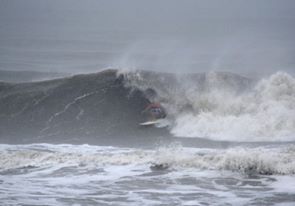USTropics wrote:chaser1 wrote:kevin wrote:Please explain it it to me if I an misunderstanding something here. But with many 30+ kt SFMR & surface wind estimates (as well as multiple 35 kt+ measurements) & a clear center with plenty of convection near it, how is this not at the very least a TD? It doesn't matter how long the TC will still have before landfall, a TD designation should not be subjective based on impacts or the presence of prior advisories, but purely on whether a system matches the requirements and as far as I can see this one does. The NHC consists of experts in their field so I'm sure they're making the right call, I just don't fully understand it myself so if anyone could clarify.
Kevin, that's a very legit question. All of the points that you made are factors toward determining whether a TD or TS has in fact developed. The only reason that I think that 92L has not been designated as a TD is the lack of identified west winds at the surface. If I were correct that would explain NHC's possible perception of this system being an open (albeit very sharp) wave or trough of low pressure. On the other hand and to your point, NHC DID claim that a small well defined center of low pressure has developed. Well, what gives?? That statement suggests a "closed circulation" and clearly having some west wind component, right? So I see how that contradiction would cause you and others question the lack of any upgrade.
I'm still seeing a low level swirl that seems to be moving WNW to NW, while some level of westerly or northwestern mid to upper level shear clearly appears to be displacing any quasi CDO (or primary convection) off to the south. I don't know to what degree the slot of dry air over the Fla panhandle and eastern Georgia/Florida may be impacting this, but right now I certainly would have a hard time saying that 92L is looking like any well played Jinga game LOL.
All in all, I think better communication could have been applied here.
You both have hit on a lot of key points here, I think the main takeaway is it's a subjective process. The four main criteria for the NHC in designating a tropical cyclone is:
1. Must be a warm core system (check)
2. Must have a low-level circulation that is fully closed off (it did that this morning)
3. Must have surface winds of 35kt+ (recon confirmed)
4. Must have persistent convection (this is the subjective part for 92L, some will say it has sustained and fired convection over the past 24 hours, some may disagree)
All in all, I think the small footprint played a role in (1) the models not showing development and (2) one of the (subjective) reasons for the NHC not classifying this. I'm good with either option, but communication/transparency and consistency can definitely be improved upon.
Agreed. Two other points that could be added but until otherwise defined, would also prove to cause subjective tropical cyclone designations-
5) Strongest (35kt +) winds must be adjacent to some Quadrant of the center of circulation, as opposed to gradient related winds well removed from the center.
6) Establish "some" persistence of time frame where 35kt SURFACE winds are/ have been actually occurring. A CDO or banding feature may be very temporary as a result of diurnal cycle or temporarily overcoming of dry air, etc.








